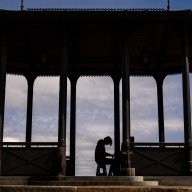Amanda Eagles got her first tattoo at 16 years old.
Since then, she’s added two more, had the original tattoo removed and racked up five piercings — four of which are above her neck. The body art has never been a problem for any of her employers, and she doesn’t expect it to become an issue when she starts working toward a career in nursing.
“I have one friend who’s a paramedic … one friend who’s a nurse, and they are covered in tattoos,” said Eagles, a 21-year-old Londoner who works at Coffee Culture. “It just seems like it’s more acceptable these days.”
Whether tattoos and piercings are still workplace taboos is up for debate as Cayla Martin, a University of Calgary graduate student, sets out on a study to answer the question once and for all.
Martin is drawing partly on her own experience in which she was told to hide her tattoos and piercings while working her way through university.
Martin and Eagles were both surprised to hear that some employers remain wary of or place bans on hiring people who have chosen to get inked.
Sue Jacobs, owner of Personal Style Image Consulting in London, isn’t as taken aback. While she would never discourage someone from getting a tattoo or piercing, stereotypes built around them continue to exist and can affect a person’s “perceived image,” she said, adding that body decoration plays a big role in first impressions.
In a job interview, where casting the right image plays a large role in being a standout candidate, body decorations may have a negative impact.
In some instances, tattoos and piercings could be “self-sabotage” when two people meet for the first time, Jacobs said.
Jacobs said people need to be more aware of the issue if they work in traditionally conservative fields like finance and insurance, where people working in more artsy, creative fields generally have a little more leeway with self-expression.
With files from Canadian Press
















